Table of contents
Affiliate marketing has enabled any website owner to earn an income online. Like any other business model, affiliate program management comes with its own rules and regulations. When joining an affiliate marketing program, you must write a disclosure that explains what it is and what it entails – not presenting an affiliate disclosure is a fatal affiliate marketing mistake.
If you’re a blogger, media brand, or cashback website looking to join an affiliate marketing program, there are essential things you need to know before you start your paid promotions. Strackr helps you store and track your affiliate data in one place – one dashboard, one API, and a range of unified tools.
In this article, we’ll discuss everything you need to know and understand about affiliate disclosure: examples and best practices.
What is Affiliate Disclosure?
Have you ever noticed those little disclaimers or statements that affiliates include when they promote products or services on their social media platforms? That’s called an affiliate disclosure. Set by the Federal Trade Commission (FTC), affiliate disclosure is a legal requirement that influencers, promoters, and affiliates must follow when they promote products or services and earn a commission from those promotions.
It’s an important aspect of affiliate marketing, particularly as not following proper affiliate disclosure protocols, as many platforms will restrict your posts, or remove them altogether. This also affects publishers too, regardless of whether they’re running a personal blog, or posting on social media.
Speaking of, if you’re an affiliate publisher looking to streamline your affiliate management processes, look no further than Strackr. With our powerful affiliate tracking and analytics platform, you can take your affiliate marketing game to the next level. Our user-friendly interface simplifies the process of managing and tracking your affiliate links and easily monitors their performance, so you can make adjustments to your affiliate strategies whenever needed.
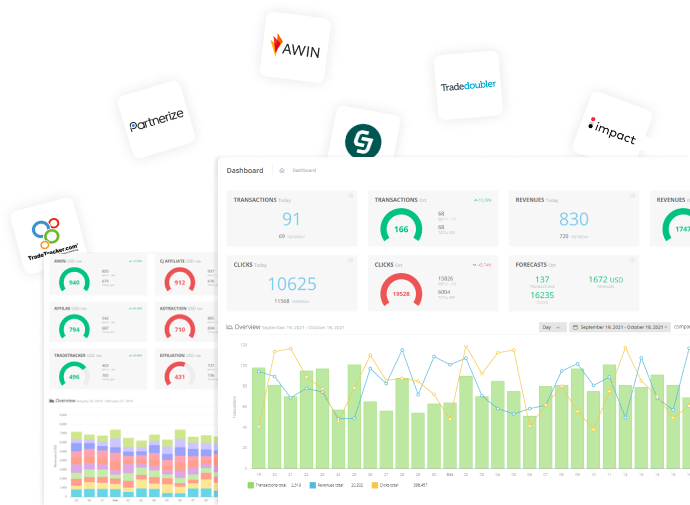
Why is Affiliate Disclosure Important?
It's essential to understand that any time you promote affiliate links to generate revenue, you have a legal obligation to disclose your financial relationships with brands and businesses. But why is it important? Here are some reasons to know:
1. Transparency
When you are transparent about your financial relationships, your audience feels confident that you have their best interests in mind. They know that you are not just promoting products or services for the sake of making money but because you genuinely believe in them.
2. Informed decision-making
Transparency also allows your followers to make informed decisions. When they are aware of your affiliations, they understand that your opinions may be influenced by these relationships and can decide if the products or services align with their own needs and values.
3. Compliance with Legal Requirements
By disclosing your affiliate relationships, you comply with legal requirements and show your commitment to transparency. You let your audience know that you have nothing to hide and that you prioritize their trust and satisfaction.
4. Consumer Protection
Affiliate disclosures not only allow you to comply with legal requirements but also prioritize the trust and satisfaction of your audience. With full transparency about your affiliate relationships, your audience can trust that the recommendations and endorsements you make are unbiased and not influenced solely by financial gain.
5. Ethical Business Practices
Additionally, affiliate disclosures also protect your followers from unethical business practices. By openly sharing your financial relationships, you demonstrate your commitment to maintaining integrity and never compromising the trust your followers have placed in you.
Affiliate Disclosure Best Practices
Here are some of the best practices you should follow when writing an affiliate disclosure:
1. Make sure readers can spot it
Ensure that your affiliate disclosure is prominently placed on your website, ideally in the footer section or near affiliate links. Place it in a spot where your website visitors or readers can easily find and access your disclosure information.
2. Use simple words and sentences
You don't want to confuse or lose your audience by using complicated or unfamiliar words; So use simple words and sentences so readers can understand and engage with your message. Plus, make sure your disclosure content is readable and engaging by addressing your readers as “you” to create a direct and personal connection with them.
3. Keep it short
Using short sentences and simple words helps to convey your message clearly and ensures that your readers can easily understand and follow along. Short, snappy sentences can create a sense of urgency and keep your readers hooked, while longer sentences can provide more detailed information or build anticipation.
4. Install an affiliate disclosure plugin
An affiliate disclosure plugin is a tool that automatically adds a disclosure statement or banner to your web pages where affiliate links are present. You can say goodbye to manually inserting disclosure statements and allow the tool to notify your readers that you may earn a commission if they purchase through the links on your site.
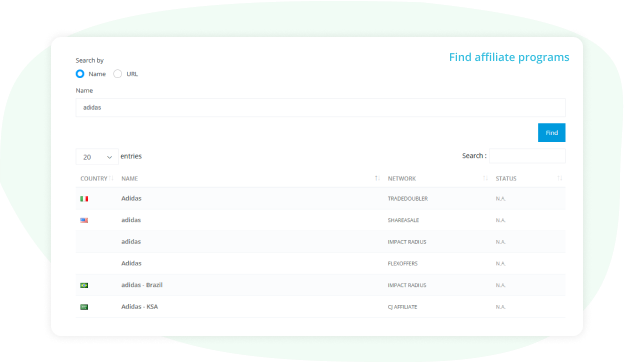
Strackr lets you find new programs easily in your sea of dozens of affiliate programs. Just paste a URL or search by name and you’ll immediately see a list of available affiliates to check if it already exists.
5. Be proactive in disclosing your partnerships
When it comes to affiliate marketing, being proactive in disclosing your partnerships is crucial. By openly informing your audience about your affiliate relationships, you not only comply with legal requirements but also build trust and maintain transparency with your readers.
In addition to installing an affiliate disclosure plugin, you may put up a dedicated affiliate disclosure page on your website to make it easier to spot and can easily provide a comprehensive explanation of your affiliate relationships.
Affiliate Disclosure Best Examples
Now that you know what affiliate disclosure is, and how to disclose all your partnerships in the best way possible, we’ll go over some examples. These will be especially helpful for affiliate publishers with blogs, as the vast majority come from blogging sites.
1. The DIY Nuts

First up is The DIY Nuts – a website run by a couple who share a passion for do-it-yourself projects. They run a blog about different DIY projects, tutorials, and how-to content. To support their website, they participate in affiliate marketing, earning a commission when someone purchases a product through their affiliate links.
When you scroll down to the bottom of their website, you’ll see their disclosure statement. Plus, they offer links for the full disclaimer, privacy policy, and terms & conditions.
2. 12 Days of Design
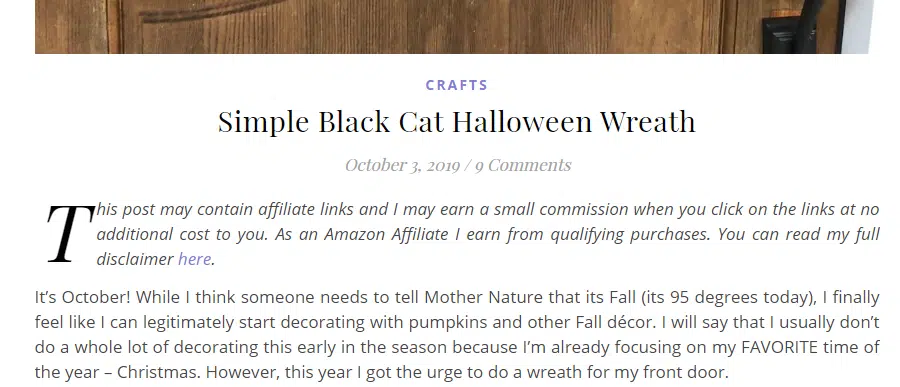
Kate Troelstra from 12 Days of Design keeps it simple and direct, and that’s all you need. She explained that she’s an Amazon Affiliate and that she may earn a small commission when readers click on the links and added that there will be no additional cost to the readers. You may also check out her full disclaimer with the link she provided in her disclosure section.
3. Cookie and Kate
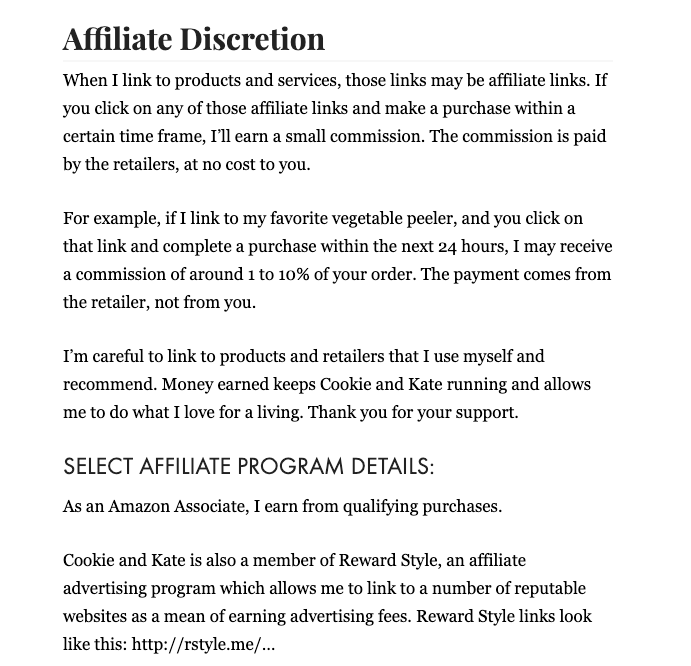
In their blog posts, Cookie and Kate provide a clear statement at the beginning or end of the post, using direct language to inform their readers. It explains well how commissions are earned through affiliate links and also lists the affiliate programs the site owner participates in.
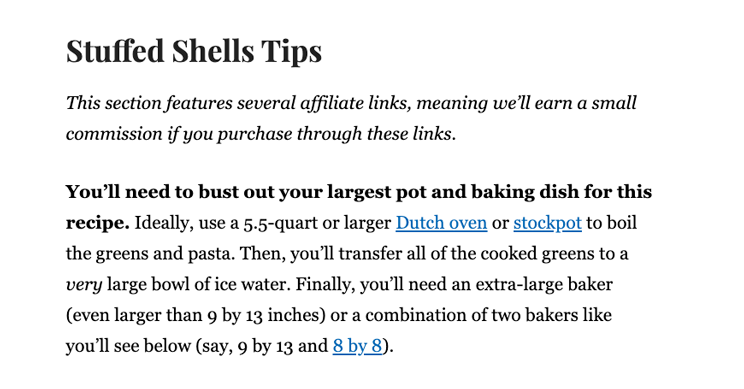
You will see an affiliate disclosure statement before the affiliate links in the site’s content and the website footer.
4. Young House Love

The Young House Love website has strategically-placed affiliate disclosure to ensure maximum visibility and accessibility for its readers. You can find their disclosure statement conveniently located in the upper right section below their short introduction. By positioning it prominently at the bottom of each page, they make it easy for visitors to find the information they need.
5. Nerdwallet
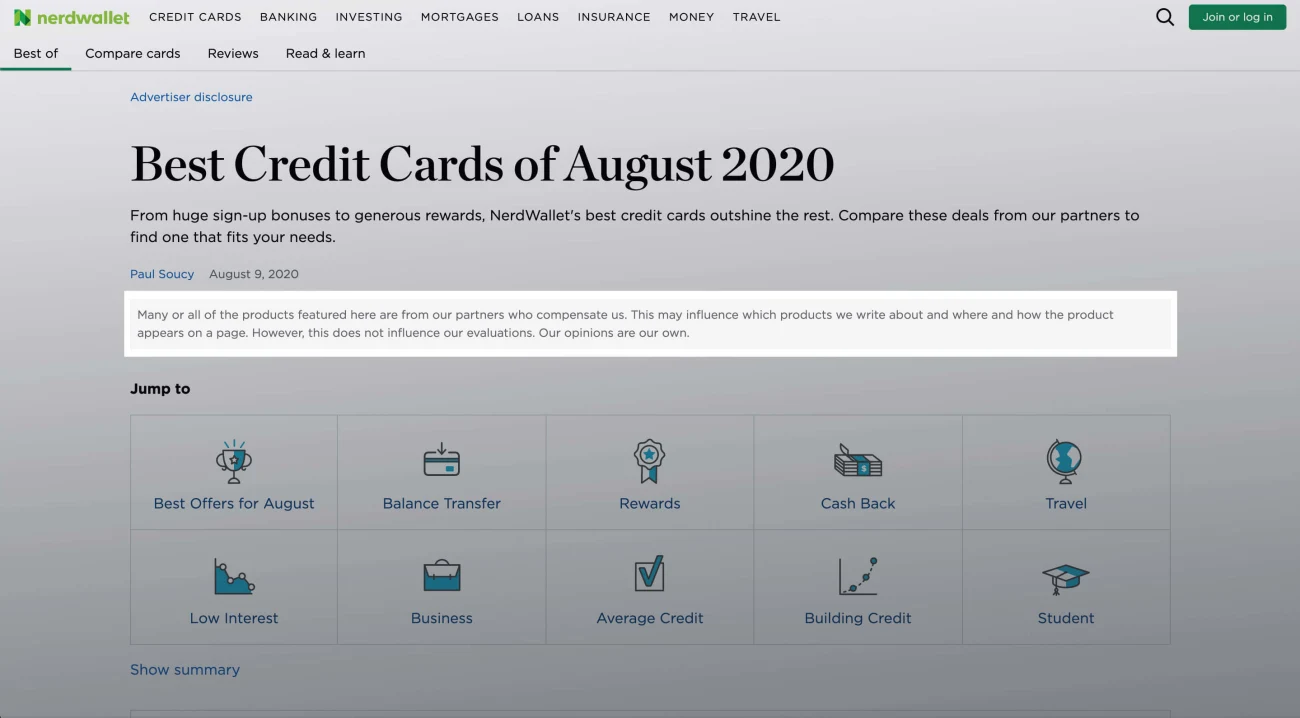
Nerdwallet takes a straightforward approach to affiliate disclosure in its blog posts. They make sure to include a clear statement at the beginning or end of the post, using plain and simple language to inform their readers.
However, their disclosure statements lack the link which redirects to a dedicated disclosure page or the site’s privacy policy for more information.
6. QuickSprout
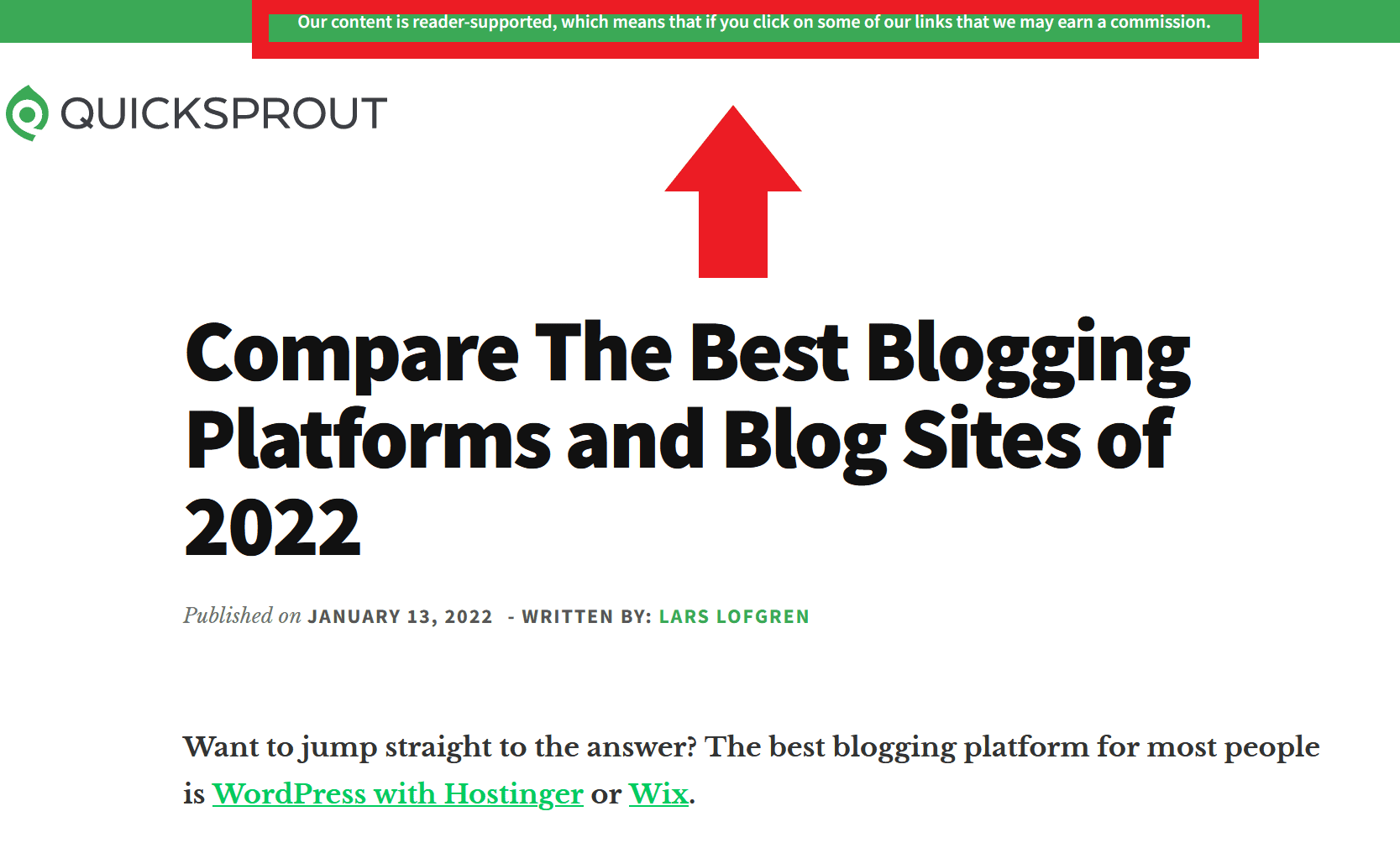
QuickSprout explained how affiliate disclosure works in just one simple yet straightforward sentence. It’s short, effective, and well-explained in a user-friendly tone. While it lacks the “learn more” link or the full disclaimer page, this example scores extra points for being completely free of any confusing or complex terminologies or industry jargon.
7. EO Fire
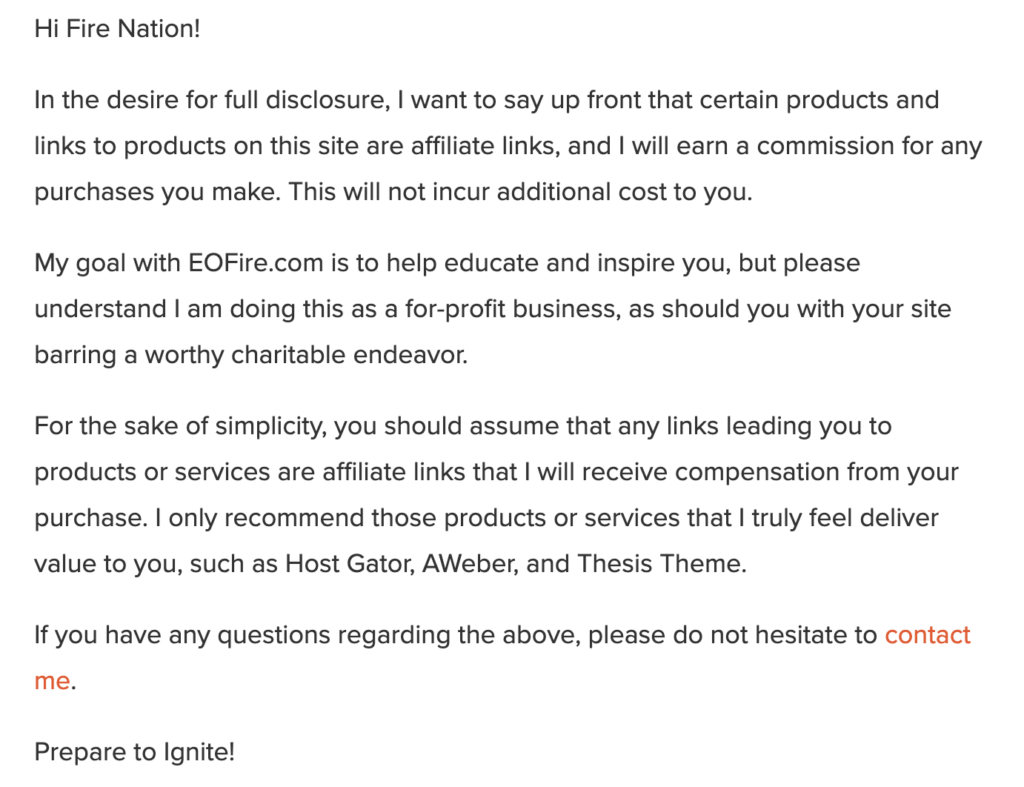
The EO Fire company recognizes the significance of making its affiliate disclaimer readily accessible to its website visitors. They have strategically positioned their disclosure statement in the footer section of their website through the term “Affiliate Disclaimer,” which ensures visibility on every page.
8. Missy Ward

As a renowned affiliate marketing expert and industry leader, Missy Ward demonstrates her commitment to transparency by incorporating her affiliate disclosure on her website in a clear and accessible manner. To help others make money through affiliate marketing, Missy Ward explicitly states that some of the links on her website are affiliate links.
9. Apartment Therapy

As a blog designed for home buyers, Apartment Therapy contains several affiliate links for decor, home furnishings, and design. Its disclosure is segmented into sections for easy reading and has an area about sponsored posts and how they work. Its disclosure is in the small italic text below the post title and image, which is a good spot for readers to detect.
Create Your Affiliate Disclosure Today!
Disclosing your affiliations shows that you value your audience's trust and are committed to providing them with transparent and honest content. This can help foster stronger relationships with your readers, leading to increased trust, loyalty, and engagement. With Strackr’s publisher tools, you can easily create tracking links to any page on an advertiser’s website in one place. Get started by creating your Strackr account here!
Share
Affiliate dashboard

Connect all your affiliate networks with Strackr to access to unified statistics and tools.
Try for free